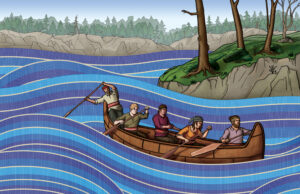
People & Culture
Rivers of resistance: A history of the Métis Nation of Ontario
“We were tired of hiding behind trees.” The ebb and flow of Métis history as it has unfolded on Ontario’s shores
- 4405 words
- 18 minutes
This article is over 5 years old and may contain outdated information.
Environment

“It may have been the promise of a railroad to the Pacific that made Canada whole,” writes Roy MacGregor in his latest book, Original Highways: Travelling the Great Rivers of Canada, “but it was rivers that carried the people west and made that railroad necessary.”
With those words, one of Canada’s most accomplished storytellers sets out to tell not only the tale of how 16 of the nation’s great rivers stitched the country together but also of what their future might hold.
From the Saint John in the east to the Mackenzie in the far northwest, MacGregor expands on his acclaimed Globe and Mail series on Canada’s rivers, bringing these historic waterways, and the stories of those whose existence is inextricably linked to them, to remarkably vivid life.
The excerpt below is from the chapter “Rising From the Dead: The Don,” which examines Toronto’s Don River.
***
It was Canada’s “Potemkin” moment.
It was the summer of 1958 and Princess Margaret was nearing the end of an extensive Royal Tour of Canada. Her well-covered travels even included British media speculation that the glamorous twenty-seven-year-old sister of the Queen had fallen for the handsome young Montreal lawyer John Turner, future prime minister of Canada, with whom she had danced and talked long into the night at a ball given at the naval base on Vancouver’s Deadman’s Island.
She had now come to Toronto, where a cancer treatment centre would take her name and where she would gather with schoolchildren across town from the hospital at the much more scenic Riverdale Park. Her specially outfitted railway car would be parked at the side of the Don River and she would have to cross over to the park via a footbridge.
The Don, the Globe and Mail editorialized on July 30, 1958, had “waters heavily polluted and laden with scum, its banks littered with all varieties of filth, and the whole sending up foul odours.”
The Royal Nose must not be allowed to sniff disapprovingly while on a tour of the colony. Not with the British press recording every moment of the Royal Tour. The city of Toronto had been scrambling. City crews had been sent out to clean up the banks, painters to give the bridge a fresh coat. What, however, were they going to do about the stink?
The solution in this time long before David Suzuki or environmental impact studies was simple: mask the smell. The city poured in chlorine and, according to several reports, gallons and gallons of perfume upstream, perfectly timed to be carried by the slow current to the park area just as the Princess was crossing over the bridge.
The Globe compared the plan to Prince Gregory Alexandrovitch Potemkin’s eighteenth-century deception of Catherine II of Russia, when the governor of the Crimea built fake village facades, cleaned and freshly painted existing buildings and ordered the peasants to clean up themselves and be smiling, happy and waving as the Empress travelled through the depressed region in her royal carriage.
The Toronto Daily Star, not to be outdone, published an editorial decrying the attempt to “sweeten the atmosphere that Her Highness may not learn how Toronto has befouled one of its beauty spots.” The newspaper compared the plan to “courtiers waving handkerchiefs dipped in perfume before the nostrils of the king of France as he drove through the tenements of Paris, that his majesty’s nostrils might not be offended by the odor from the open drains.”
“The fact that this deception at the Don is necessary,” railed the Globe, “is a disgrace to Toronto and to this Province. The river should be cleaned up in fact; and not just for a day, but for good.”
Nothing, of course, was done. The Princess’s official visit was a resounding success, the schoolchildren delighted and the air at Riverdale Park strangely sweet—for a few hours.
Jennifer Bonnell, an urban historian at York University, captures the sad fate of this river that bisects Canada’s largest, busiest city in her belief that the Don River has been the “most-messed-with river” in Canada.
It is difficult to imagine today, but long before Muskoka was packed with expensive summer homes, the Don River was what Torontonians called “cottage country.” The original “cottager” was Elizabeth Posthuma Gwillim Simcoe, wife of John Graves Simcoe, first lieutenant-governor of Upper Canada.
Elizabeth liked her creature comforts. She may have once been a Welsh orphan but she had inherited two family fortunes before marrying Simcoe. He was thirty-one, she only sixteen. He had fought for Britain in the American War of Independence—commanding the unit that burned down Richmond, Virginia—and had since been sent to the remaining colony to build Fort York. This new lieutenant-governor named the nearby river the Don, as he said it reminded him of the River Don in South Yorkshire, England.
The strong-willed Elizabeth grew to hate the muggy summers of muddy York. She first sought relief from the irrepressible heat by taking to the little peninsula that would later form the Toronto Islands, and here she ordered so many brush fires set to ward off the mosquitoes that other residents began to regard her as a threat to the community. The bugs, she claimed, made it impossible for her to do her small watercolours and intricate pen-and-ink drawings, and it was this passion for breezy spaces and new landscape that took her farther afield than perhaps the wife of the fort commander was expected to wander.
In the mid-1790s, Elizabeth convinced her husband to build her a summer home in the “north country.” She chose a bluff overlooking a deep, wide valley and its narrow, pastoral Don River, roughly where subway riders today find the Castle Frank stop on the Bloor line. Here they built a log home, complete with gaudy Grecian columns, that the Simcoes named after their youngest son, Francis; hence, Castle Frank.
John Graves and Elizabeth Simcoe stayed only four years in what would become Toronto. Their little daughter Katherine, only fifteen months of age, was buried just outside the walls of Fort York in the spring of 1794, and by 1796 the Simcoes were once again back to England. Poor Francis, the namesake of the first regal “cottage” in Canada, was killed in action fighting for England in the Peninsular War, and John Graves himself died in 1806, just prior to taking up his new and much-longed-for appointment as governor general of India.
Elizabeth’s heart, however, remained on that bluff overlooking the Don River. Her final “Canadian” entry in her diary, dated July 21, 1796, sounds very much like a Labour Day lament from “cottage country” two centuries on: “I was so much out of spirits. I could not eat, cried all the day.”
What happened to the Don that so captured the affection of someone so refined and particular as Elizabeth Simcoe? In her highly readable 2014 environmental history of the river and valley, Reclaiming the Don, Professor Bonnell shows how this river, once so prized for its beauty, its mouth once blessed with one of the largest marshlands in Lake Ontario, saw that lovely mouth twisted and recast, its meandering route straightened for convenience, its tributaries paved and built over and often lost, its water fouled to the point where, twice, the river caught fire.
“It’s a total buried story,” says Bonnell, who came across the fire reports in the city’s Port Authority archives. “It’s in the newspapers but it doesn’t warrant any front-page mention. It was completely buried. When rivers were catching fire in the nineteen-thirties and forties it was just considered the cost of doing business. It’s like, ‘Oh, well.’
The Don River eventually became the Canadian poster child for water pollution, just as Ohio’s Cuyahoga River, which dramatically caught fire in 1969, became the symbol for what had gone wrong with America’s waterways. No amount of perfume could mask the reality of the appalling, stinking Don.
In the fall of 1969, a couple of hundred mourners paraded a casket from the University of Toronto grounds to the banks of the Don. The cortège included a “hearse,” a band playing a dirge, a weeping widow in black and a pie in the face for a top-hatted student portraying a greedy capitalist.
Monte Hummel, now president emeritus of WWF-Canada, was a key player in that parade. Earlier in the summer of 1969, Hummel had spent his honeymoon at Woodstock—he’s the “hippie” organizing the famous mudslide in the 1970 movie of the musical event—and then loaded his canoe on a Volkswagen to continue the honeymoon in Northwestern Ontario. At Whitedog Falls near Kenora, he found signs advising people to “Fish for Fun.” So polluted had the waters of the Winnipeg River become from mercury poisoning that the fish were inedible. It was a moment that changed his life and would, eventually, set his career.
Hummel returned to the University of Toronto, where he was finishing up a master’s degree in philosophy. Along with zoology professor Don Chant, he helped found Pollution Probe at University of Toronto, soon to be known more widely as Pollution Probe. They decided to focus on the nearby Don River, which Hummel says was “pretty disgusting” at the time.
Pollution Probe then came up with the idea—“It wasn’t mine,” says Hummel—of holding their “funeral” for the Don River. Meredith Ware, an arts student, played the role of Elizabeth Simcoe and read excerpts from Simcoe’s diary. The diary spoke of loons on the water surface, salmon below, with the waters “beautifully clear and transparent.”
Another student, Tony Barrett, played the cigar-chomping, top-hatted capitalist who kept shouting things like, “That’s the smell of money! What’s wrong with you people?”
“People do these things all the time now,” says Hummel, “but back then this was a new idea—it hadn’t been done before. There was no Ministry of the Environment then. There was no Environmental Protection Act. ‘Pollution’ was seen as akin to ‘communism.’ This whole notion that you could kill a river had never been thought of before. There was a poignant message that rose above the street theatre.”
It did indeed, the Sunday afternoon parade along College Street capturing the attention of the media.
“They finally had a funeral for the Don River yesterday,” the Toronto Telegram reported the following day. “Judging from the smell of the ‘deceased,’ it was long overdue.”
Are you passionate about Canadian geography?
You can support Canadian Geographic in 3 ways:

People & Culture
“We were tired of hiding behind trees.” The ebb and flow of Métis history as it has unfolded on Ontario’s shores

Environment
David Boyd, a Canadian environmental lawyer and UN Special Rapporteur on Human Rights and the Environment, reveals how recognizing the human right to a healthy environment can spur positive action for the planet

Places
Not all, but many of Canada's national parks will reopen to some extent on June 1

Environment
Mark Angelo, founder of BC Rivers Day and World Rivers Day, shares insights on his love of rivers, his forthcoming film and what can be done to protect the planet’s waterways